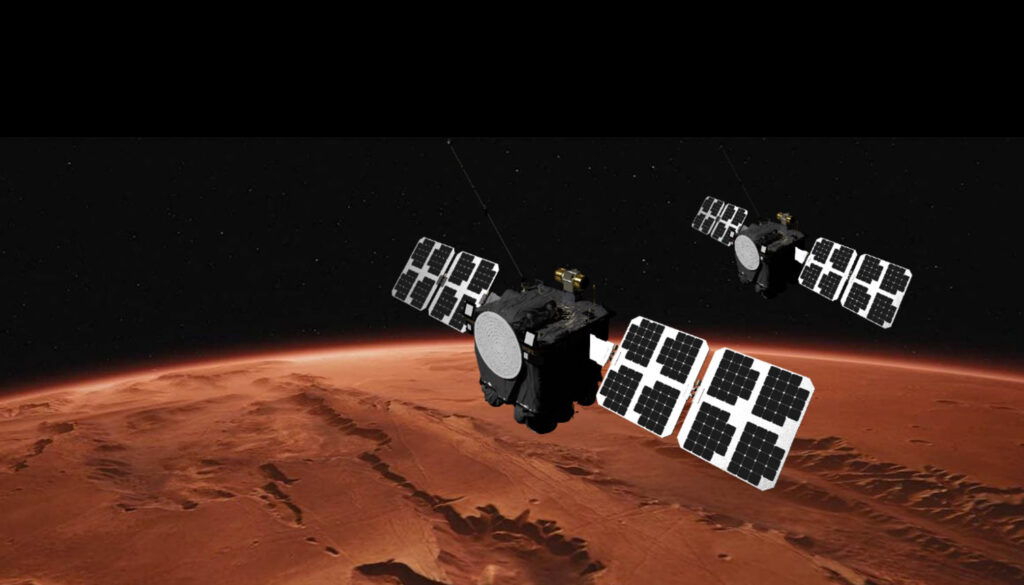
The first dual-satellite mission to another planet, NASA’s ESCAPADE (Escape and Plasma Acceleration and Dynamics Explorers), is on track for a November launch from Cape Canaveral, Florida. Managed and operated by the University of California, Berkeley, the mission features two identical spacecraft that will fly in formation to map Mars’ magnetic fields, upper atmosphere, and ionosphere in 3D. This mission promises to deliver the first stereo view of the Red Planet’s unique near-space environment.
The insights gained from ESCAPADE will be pivotal in understanding how and when Mars lost its atmosphere, offering crucial data about conditions on the planet that could impact future human missions. “Understanding how the ionosphere varies will be a really important part of understanding how to correct the distortions in radio signals that we will need to communicate with each other and to navigate on Mars,” explained ESCAPADE principal investigator Robert Lillis of UC Berkeley’s Space Sciences Laboratory (SSL).
Mission Details and Objectives
Nicknamed Blue and Gold after UC Berkeley’s school colors, the satellite pair will arrive at Mars in 2027. They will be operated from SSL’s mission operations center in the hills above the Berkeley campus. The science instruments, deployable booms, and data processing computers were developed by UC Berkeley and its partners, while Rocket Lab USA, based in Long Beach, California, constructed the ESCAPADE spacecraft. The mission will be launched aboard a New Glenn rocket from Blue Origin, headquartered in Kent, Washington.
Mapping Mars’ magnetic fields and their response to space weather is critical because the planet lacks a global magnetic field like Earth’s, as well as a thick atmosphere to protect its surface from harmful solar storms. Consequently, anyone on Mars would need to shield themselves from high-energy particle radiation, which can damage DNA and increase cancer risk. “We will be making the space weather measurements we need to understand the system well enough to forecast solar storms whose radiation could harm astronauts on the surface of Mars or in orbit,” Lillis stated.
Innovative Trajectory and Launch Strategy
ESCAPADE is set to pioneer a novel trajectory to Mars. Traditionally, missions to Mars are launched during a narrow window every 26 months, allowing spacecraft to take the most fuel-efficient route. This method, known as a Hohmann Transfer, typically takes seven to eleven months. ESCAPADE, however, will first travel to a Lagrange point, where the gravitational pull of the sun and Earth are equal, before looping around in a 12-month orbit that brings it back toward Earth in November 2026. At its closest approach, ESCAPADE will use Earth’s gravity to slingshot toward Mars.
Jeffrey Parker of Advanced Space LLC, a NASA partner on ESCAPADE, noted, “Can we launch to Mars when the planets are not aligned? ESCAPADE is paving the way for that.”
Scientific Goals and Historical Context
UC Berkeley has been sending experiments to Mars for nearly 60 years, revealing insights into its atmosphere, magnetic fields, and space weather. Instruments from Berkeley have been part of missions such as NASA’s Mars Global Surveyor, which launched in 1996 and discovered Mars lost its global magnetic field around 4 billion years ago. Currently, Berkeley’s instruments are aboard NASA’s MAVEN and the Emirates Mars Mission Hope probe, both of which continue to study Mars’ atmosphere and auroras.
ESCAPADE’s two probes will provide a 3D view of how the Martian atmosphere responds to solar wind, a stream of charged particles from the sun. The mission aims to enhance understanding of how the solar wind energizes particles and facilitates their escape into space. “To understand how the solar wind drives different kinds of atmospheric escape is a key piece of the puzzle of the climate evolution of Mars,” Lillis said.
The data could illuminate what happened to Mars’ water, which once filled lakes and rivers, and whether it remains underground for future use. “The geological evidence shows that Mars once had water on it, and in order to keep the water, you need a thick atmosphere,” noted space physicist Shaoxui Xu, deputy principal investigator for the mission.
Technological Innovations and Future Implications
ESCAPADE represents a shift in mission strategy, characterized by lower costs, increased commercial involvement, and a higher tolerance for risk. Lillis stated, “The reliability of individual components and subsystems has improved, so it’s possible to send two spacecraft to Mars for roughly one-tenth of what it would have cost 10 or 15 years ago.”
Once the satellites reach Mars, they will take approximately seven months to adjust into synchronized orbits, allowing them to monitor the Martian environment with unprecedented detail. “When we have two spacecraft crossing those regions in quick succession, we can monitor how those regions vary on timescales as short as two minutes and up to 30 minutes,” Lillis explained.
The UC Berkeley instruments onboard include electrostatic analyzers to measure the energy and direction of escaping particles. NASA’s Goddard Space Flight Center contributed a magnetic field detector, and Florida’s Embry-Riddle Aeronautical University built a device to measure plasma around the spacecraft. An onboard camera from Northern Arizona University will capture images of dust and auroras on Mars.
Conclusion and Future Prospects
While the challenges of establishing a human settlement on Mars are significant, the data from ESCAPADE could be instrumental in overcoming them. “It is definitely going to be a challenge to establish a human settlement on Mars,” Lillis remarked. “But, you know, humans are tenacious, right?”
As ESCAPADE prepares for its groundbreaking mission, it not only promises to expand our understanding of Mars but also to pave the way for future human exploration and settlement on the Red Planet.





